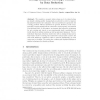Free Online Productivity Tools
i2Speak
i2Symbol
i2OCR
iTex2Img
iWeb2Print
iWeb2Shot
i2Type
iPdf2Split
iPdf2Merge
i2Bopomofo
i2Arabic
i2Style
i2Image
i2PDF
iLatex2Rtf
Sci2ools
ESA
2004
Springer
2004
Springer
Solving Geometric Covering Problems by Data Reduction
We consider a scenario where stops are to be placed along an already existing public transportation network in order to improve its attractiveness for the customers. The core problem is a geometric set covering problem which is NP-hard in general. However, if the corresponding covering matrix has the consecutive ones property, it is solvable in polynomial time. In this paper, we present data reduction techniques for set covering and report on an experimental study considering real world data from railway systems as well as generated instances. The results show that data reduction works very well on instances that are in some sense “close” to having the consecutive ones property. In fact, the real world instances considered could be reduced significantly, in most cases even to triviality. The study also confirms and explains findings on similar techniques for related problems.
Related Content
| Added | 01 Jul 2010 |
| Updated | 01 Jul 2010 |
| Type | Conference |
| Year | 2004 |
| Where | ESA |
| Authors | Steffen Mecke, Dorothea Wagner |
Comments (0)

